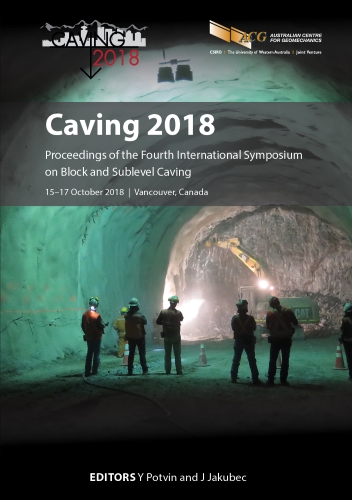The role of research in cave mining

|
Authors: McKinnon, SD; Ferguson, GA |
DOI https://doi.org/10.36487/ACG_rep/1815_38_McKinnon
Cite As:
McKinnon, SD & Ferguson, GA 2018, 'The role of research in cave mining', in Y Potvin & J Jakubec (eds), Caving 2018: Proceedings of the Fourth International Symposium on Block and Sublevel Caving, Australian Centre for Geomechanics, Perth, pp. 499-510, https://doi.org/10.36487/ACG_rep/1815_38_McKinnon
Abstract:
There are many reasons to carry out research in mining operations and its associated technical disciplines, such as solving fundamental problems and adapting new technologies to the mining environment. Carrying out research is not the primary business of mining companies, although it is vital to the long-term health of the industry. In this paper, the differences between fundamental research, innovation and consulting are described, as is how to identify where on the research and development (R&D) spectrum a research project should be positioned. Further, the role of different organisations in conducting R&D work is discussed. Planning and managing research projects and programs can have a significant influence on the cost and success of projects even if they are outsourced to specialist practitioners, which is a common practice in research work today. An example of how the planning and positioning of R&D projects can be assisted by classification methods is given. Finally, some research areas that are of particular relevance to cave mining are suggested.
Keywords: R&D, innovation, cave mining problems, mining-induced seismicity, preconditioning
References:
Catalán, A, Onederra, I & Chitombo, G 2012, ‘A proposed methodology for evaluation of the preconditioning by blasting at the Cadia East panel cave mine’, Proceedings of MassMin 2012, Canadian Institute of Mining, Metallurgy and Petroleum, Westmount.
He, Q, Suorineni, FT & Oh, J 2016, ‘Review of hydraulic fracturing for preconditioning cave mining’, Rock Mechanics and Rock Engineering, vol. 49, pp. 4893–4910.
Hustrulid, W 2006, ‘Some thoughts about mining, rock mechanics and butterflies’, in P Yale (ed.), Proceedings of the 41st U.S. Rock Mechanics Symposium, vol. 1, American Rock Mechanics Association, Alexandria.
International Organization for Standardization 2018, ISO 31000:2018, Risk Management – Guidelines, International Organization for Standardization, Geneva.
Lewis, M 2016, The Undoing Project: A Friendship That Changed Our Minds, W. W. Norton & Company, New York City.
Jakubec, J, Clayton, R & Guest, AR 2012, ‘Mudrush risk evaluation’, Proceedings of MassMin 2012, Canadian Institute of Mining, Metallurgy and Petroleum, Westmount.
Leach, A 2014, ‘Is increasing mining R&D the only hope for saving a stalling industry?’, Mining Technology, viewed 25 July 2018,
Mencken, HL 1917, ‘The divine afflatus’, New York Evening Mail, 16 November 1917.
Ontario Ministry of Labour 2015, Final Report: Mining Health, Safety and Prevention Review, viewed 25 July 2018,
Pardo, C & Rojas, E 2016, ‘Selection of exploitation method based on the experience of hydraulic fracture techniques at the El Teniente mine’, Proceedings of MassMin 2016, The Australasian Institute of Mining and Metallurgy, Melbourne.
Widijanto, E, Sunyoto, WS, Wilson, AD, Yudanto, W & Soebari, L 2012, ‘Lessons learned in wet muck management in Ertsberg East Skarn System of PT Freeport Indonesia’, Proceedings of MassMin 2012, Canadian Institute of Mining, Metallurgy and Petroleum, Westmount.
© Copyright 2026, Australian Centre for Geomechanics (ACG), The University of Western Australia. All rights reserved.
View copyright/legal information
Please direct any queries or error reports to repository-acg@uwa.edu.au
View copyright/legal information
Please direct any queries or error reports to repository-acg@uwa.edu.au
